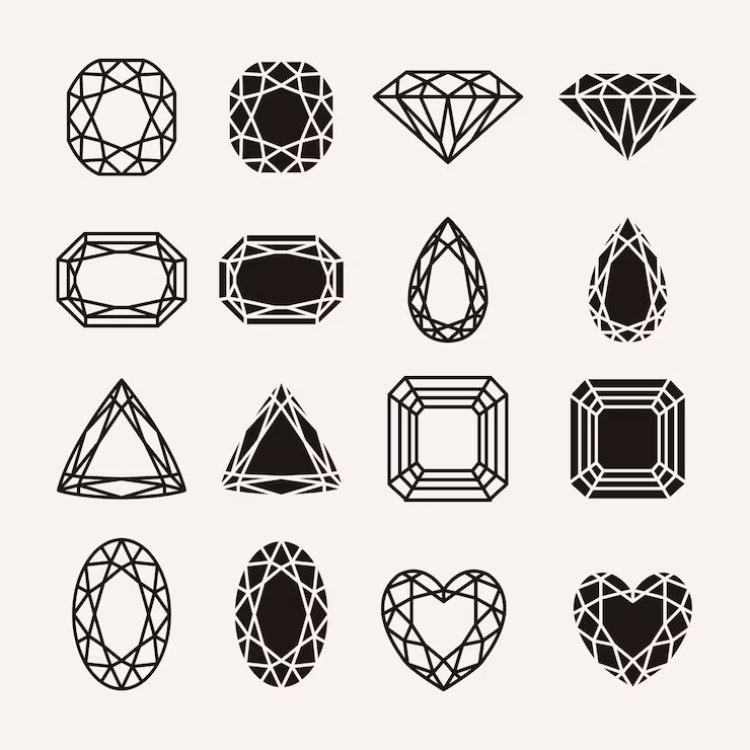The History and Evolution of Diamond Cuts
Discover the fascinating history and evolution of diamond cuts, from early Point Cuts to modern Brilliant and Fancy Cuts. Learn how advancements in technology have enhanced the brilliance of both natural and lab grown diamond rings, including lab grown solitaire rings and diamond engagement rings. Explore the artistry and craftsmanship behind these timeless gems.
Share this Post to earn Money ( Upto ₹100 per 1000 Views )

Diamonds have captivated humanity for centuries, celebrated for their brilliance and timeless beauty. The art of cutting diamonds has evolved dramatically over time, driven by advancements in technology and changes in aesthetic preferences. This journey through the history and evolution of diamond cuts will help you appreciate the intricate craftsmanship behind every diamond, whether it’s a lab grown diamond ring or a natural diamond engagement ring.
The Early Days of Diamond Cutting
Point Cut

In the early days, diamonds were valued primarily for their rarity and hardness rather than their sparkle. The first known diamond cut, the Point Cut, appeared in the 14th century. It retained the natural octahedral shape of the diamond crystal, with minimal faceting to enhance its shape.
Table Cut

The Table Cut emerged in the 15th century, marking a significant development in diamond cutting. This cut involved flattening one side of the diamond to create a table-like surface, which allowed for better light reflection and increased brilliance compared to the Point Cut.
Renaissance to the Baroque Period
Rose Cut

During the Renaissance, the Rose Cut became popular. This cut featured a flat base with a dome-shaped top covered in triangular facets. The Rose Cut was particularly admired for its ability to sparkle under candlelight, making it a favorite choice for jewelry in the 16th and 17th centuries.
Old Mine Cut

The Old Mine Cut, developed in the 18th century, was a precursor to the modern Brilliant Cut. It had a squarish shape with rounded corners and a high crown. This cut maximized the diamond's fire and brilliance, laying the foundation for future advancements in diamond cutting.
The Brilliant Cut Revolution
Old European Cut
The Old European Cut, popular in the 19th century, was the direct ancestor of the modern Brilliant Cut. It featured a round shape with a high crown, small table, and large culet. The cut's symmetrical facets significantly improved the diamond's sparkle, making it a preferred choice for engagement rings.
Modern Round Brilliant Cut

In the early 20th century, the Round Brilliant Cut was perfected. This cut, with its 58 facets, optimized light reflection and refraction, enhancing the diamond's brilliance and fire. Today, the Round Brilliant Cut remains the most popular choice for diamond engagement rings, whether they are lab grown or natural.
Contemporary and Fancy Cuts
Princess Cut
Introduced in the 1960s, the Princess Cut is known for its modern, square shape and exceptional brilliance. It quickly became a popular choice for diamond engagement rings, including lab grown diamond engagement rings, due to its contemporary appeal and impressive sparkle.
Cushion Cut

The Cushion Cut, with its rounded corners and larger facets, combines vintage charm with modern brilliance. This cut, reminiscent of the Old Mine Cut, has seen a resurgence in popularity for both natural and lab grown diamond rings.
Emerald Cut

The Emerald Cut, characterized by its rectangular shape and step-cut facets, offers a unique, elegant look. Its clean lines and understated sparkle make it a favorite for those seeking a sophisticated diamond engagement ring.
Other Fancy Cuts
Fancy cuts, such as the Marquise, Oval, Pear, and Heart, have become increasingly popular in recent years. These cuts offer unique shapes and styles, allowing for more personalized and distinctive diamond jewelry designs.
The Impact of Technology
Modern technology has revolutionized diamond cutting, enabling precise and intricate designs that were once unimaginable. Computer-aided design (CAD) and laser cutting have allowed for greater accuracy and creativity, ensuring that every facet is perfectly aligned to maximize a diamond's brilliance.
This technological advancement has benefited both natural and lab grown diamonds. Lab grown diamond rings, for instance, can now be cut with the same precision and care as their natural counterparts, resulting in stunning pieces like lab grown solitaire rings that rival the beauty of traditional diamonds.
Conclusion
The history and evolution of diamond cuts reflect a blend of artistry, technology, and changing tastes. From the rudimentary Point Cut to the sophisticated Brilliant and Fancy Cuts, each stage in this journey has contributed to the dazzling array of diamond jewelry available today. Whether you’re considering a lab grown diamond ring, a natural diamond engagement ring, or a labgrown solitaire ring, understanding the evolution of diamond cuts will deepen your appreciation for these timeless gems.
As diamond cutting techniques continue to advance, the future promises even more innovative and breathtaking designs, ensuring that the allure of diamonds will continue to shine brightly for generations to come.

 finediamondsrus
finediamondsrus 






